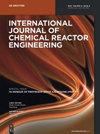用于海水淡化吸收式热变压器的粗糙表面蒸发器的评价
IF 1.6
4区 工程技术
Q3 Chemical Engineering
International Journal of Chemical Reactor Engineering
Pub Date : 2023-02-24
DOI:10.1515/ijcre-2022-0113
引用次数: 0
摘要
摘要本研究的目的是评估用于海水淡化单级吸收式热变压器(SAHT-WD)的粗糙结构蒸发器的性能。不锈钢蒸发器经过研磨材料释放处理(喷砂纹理),与光滑表面相比,提供了促进相变传热的纹理。为了确定蒸发器的性能,评估分为实验和理论分析两部分。实验分析的重点是确定有利于蒸发器和SAHT-WD性能的操作条件。在理论分析方面,建立了预测蒸发器润湿效率和换热系数的数学模型。为了量化粗糙表面蒸发器性能的改善,将实验结果与参考文献的结果进行了比较。结果表明,喷砂结构改善了蒸发器和SAHT-WD的性能。数学模型结果表明,粗管提高了蒸发器的润湿效率。本文章由计算机程序翻译,如有差异,请以英文原文为准。
Evaluation of a rough-surface evaporator applied to an absorption heat transformer for water desalination
Abstract The purpose of this work is to evaluate the performance of a rough-textured evaporator applied to a single-stage absorption heat transformer for water desalination (SAHT-WD). The stainless-steel evaporator was subjected to an abrasive material release treatment (sandblast texture) to provide a texture that fosters phase change heat transfer compared to a smooth surface. To determine the performance of the evaporator, the evaluation has been divided into an experimental and a theoretical analysis. The experimental analysis focused on determining the operating conditions that favor the performance of the evaporator and the SAHT-WD. For the theoretical analysis, a mathematical model was developed to predict the wetting efficiency and the heat-transfer coefficients of the evaporator. To quantify the improvement in the performance of the rough-surface evaporator, the experimental results were compared with those reported in a reference work. The results indicate that the sandblasted texture improved the performance of the evaporator as well as that of the SAHT-WD. The results of the mathematical model suggest that the rough tube improved the wetting efficiency of the evaporator.
求助全文
通过发布文献求助,成功后即可免费获取论文全文。
去求助
来源期刊
CiteScore
2.80
自引率
12.50%
发文量
107
审稿时长
3 months
期刊介绍:
The International Journal of Chemical Reactor Engineering covers the broad fields of theoretical and applied reactor engineering. The IJCRE covers topics drawn from the substantial areas of overlap between catalysis, reaction and reactor engineering. The journal is presently edited by Hugo de Lasa and Charles Xu, counting with an impressive list of Editorial Board leading specialists in chemical reactor engineering. Authors include notable international professors and R&D industry leaders.

 求助内容:
求助内容: 应助结果提醒方式:
应助结果提醒方式:


